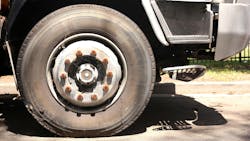Key takeaways:
- The CSA program enhances enforcement officials’ ability to identify carriers with deficiencies, reducing evasion of inspections.
- Improved coating and refinishing techniques for steel and aluminum wheels enhance durability and safety, making underlying issues easier to spot.
- Maintaining wheels and rims in good condition minimizes the likelihood of roadside inspections and helps avoid negative attention related to poor CSA scores.
In 2010, the federal Compliance, Safety, Accountability program changed how fleets maintain equipment. For the first time, enforcement officials had a roadmap for identifying carriers with operational deficiencies. Before CSA, drivers and vehicles with insufficiencies often slipped through the cracks. A truck with no violations would be selected for a roadside inspection, while another could drive right past the scale with multiple safety-related problems. After CSA began, it became much more difficult for deficient carriers to avoid enforcement.
Shortly after implementation, I spent some time with a long-time state trooper responsible for roadside inspections. He explained that, on average, he had less than 10 minutes to assess a vehicle's condition and the driver's status. In this game of hit-and-miss, less-than-stellar carriers sometimes evade enforcement because there are not enough officers or time to inspect every commercial motor vehicle on the road.
Maintenance scores became a flashing red light for the tire and wheel industry. Carriers with poorly maintained vehicles were easily identified, and those with tire and wheel issues could count on tread depth checks at a minimum. One visual sign that blinked the loudest and brightest was the condition of the wheels or rims. For steel wheels/rims, corrosion was a sign of a wheel end in need of extra attention, and aluminum rims with dull or cloudy appearances signified the potential for further maintenance violations.
Steel wheel/rim reconditioning was not a new concept in 2010. Some carriers already saw value in refinishing—but not without occasional problems. At the time, the process was very dependent on the technician doing the work. Coatings were applied by hand, which increased the possibility of uneven thickness. On the weather side, inconsistencies affected the cosmetic appearance. A wheel-off could occur if the coating on the mating surface of the wheel where it contacts the hub, drum, or another wheel in a dual application is uneven or too thick.
Aluminum wheel refinishing at the time had its challenges. Caustic cleaning solutions could remove protective coatings and expose the surface to corrosion. There were also environmental concerns related to the disposal of the chemicals after cleaning, which too often resulted in irresponsible practices.
See also: How using trend data can help your fleet improve its CSA scores
A lot has changed since 2010—and mainly for the better. On the steel wheel/rim side, coating removal processes have improved, so the life of the finish has improved. In addition, the coatings are more advanced, and there is less dependency on technicians to control the thickness. Industry standards set the maximum thickness at 3.5 mils, and current technology results in a more consistent coating on all surfaces. One method for determining the quality of the finish is to check the rim stamp after reconditioning. If the removal process makes the stamp difficult to read and/or the coating has the same effect, the process does not meet the industry standard of care.
The condition of the stamp also applies to aluminum wheel refinishing or polishing. Cleaning methods cannot make the stamp difficult to read. Likewise, if the wheel is polished to the point where the stamp is faintly visible or completely removed, it doesn't meet industry best practices.
Wheel and rim reconditioning programs create more than cosmetic advantages. It’s much easier to identify any cracks or damage after removing the old coating on the steel side. Out-of-service conditions are also more evident on aluminum wheels after the cleaning process. The offending assembly or assemblies will be carefully analyzed and inspected in a wheel-off accident. When they are reduced to bare metal, the problems that lead to the loss of a wheel or wheels can be avoided.
Commercial motor vehicles with wheels and rims in good condition will be scrutinized less by enforcement officials with or without CSA. Regular inspection and refinishing or polishing will also improve the life and performance.
Wheels and rims are critical components that cause major problems when they fail. Fleets that invest in maintaining the appearance of wheels and rims will recognize both direct and indirect benefits. While it won’t hide poor CSA scores for maintenance, it will give the officer one less reason to conduct a roadside inspection. Conversely, corrosion and poor appearance on the wheel end attract the type of attention that carriers do not want.
About the Author
Kevin Rohlwing
Kevin Rohlwing is the SVP of training for the Tire Industry Association. He has more than 40 years of experience in the tire industry and has created programs to help train more than 180,000 technicians.
